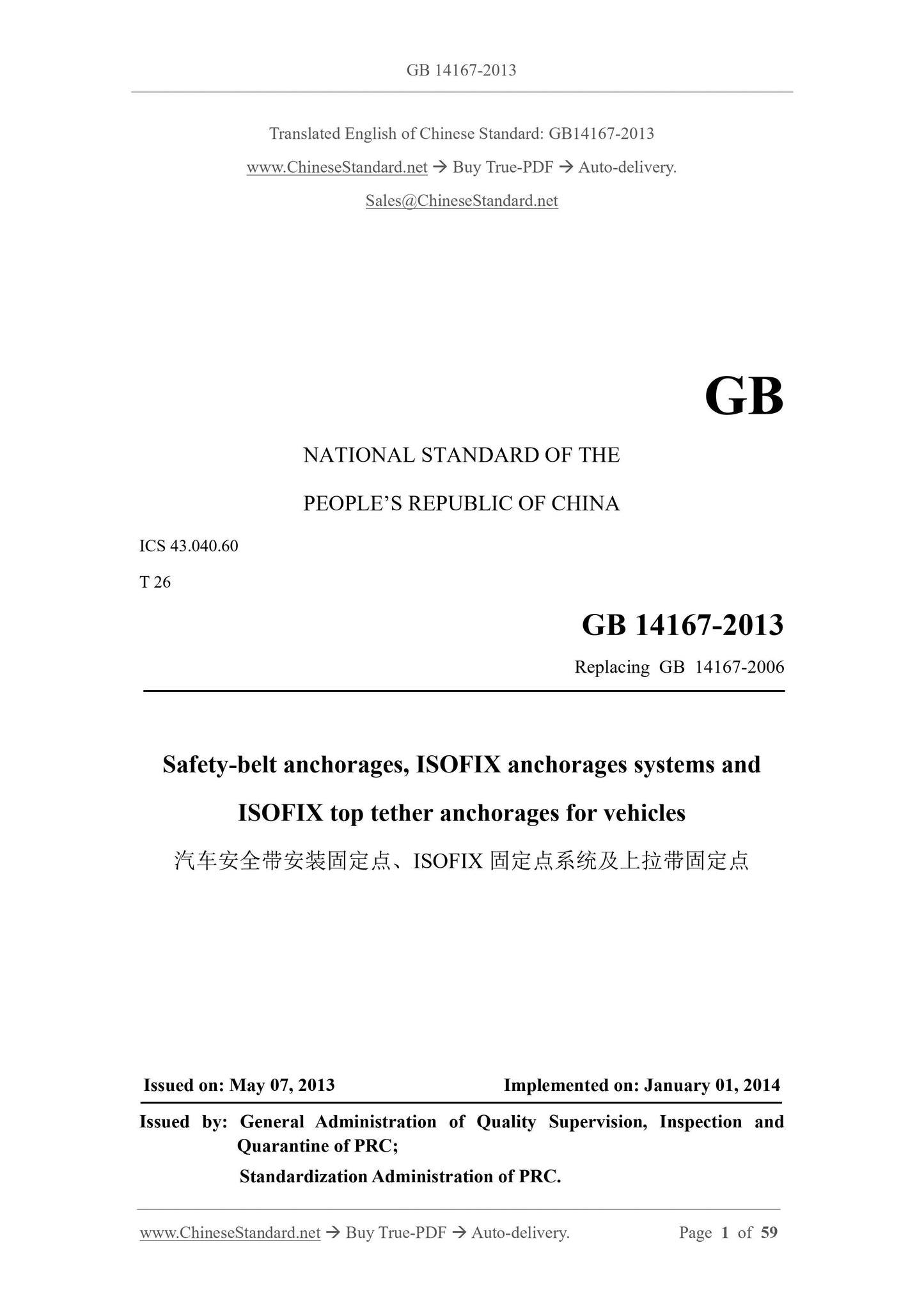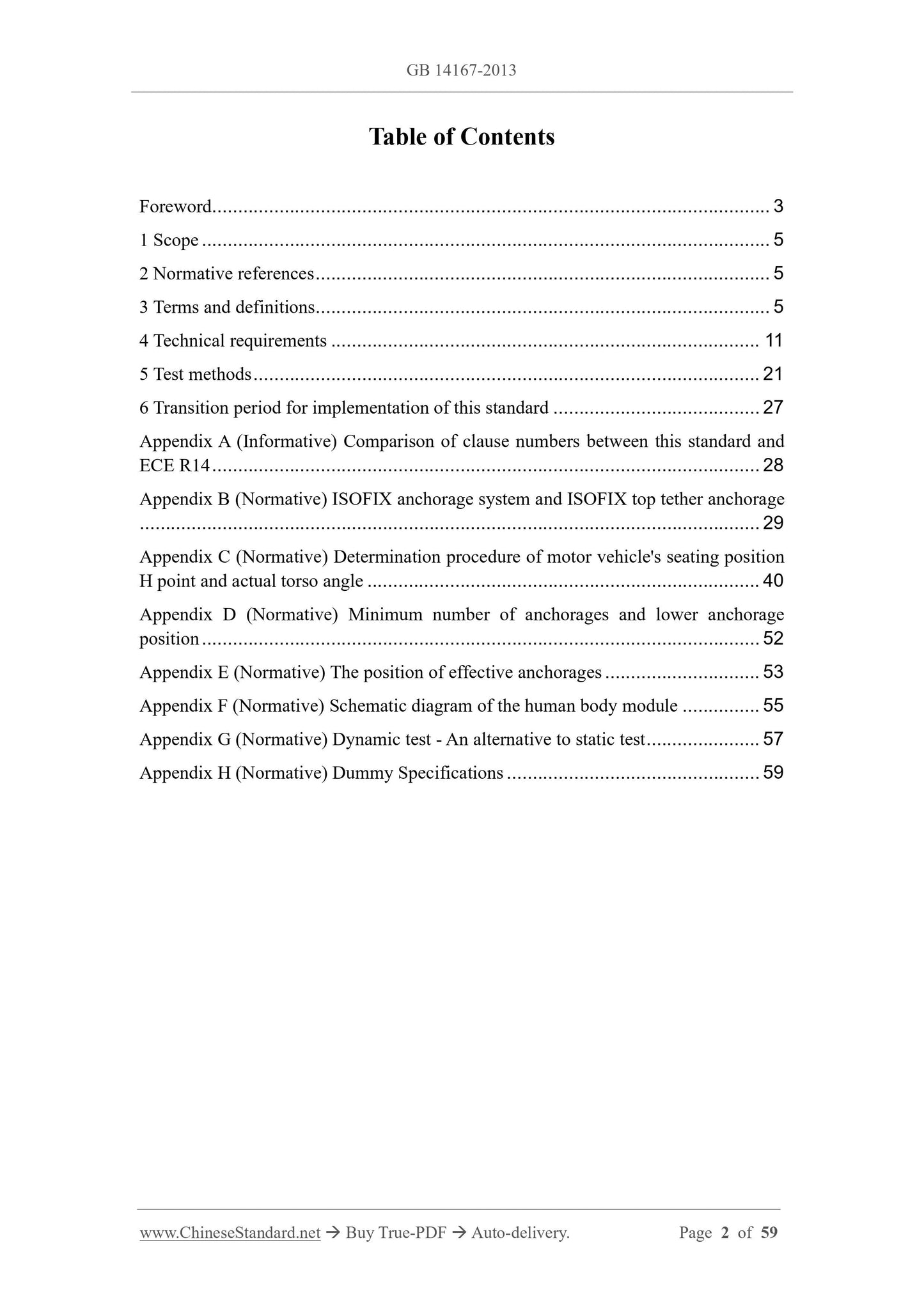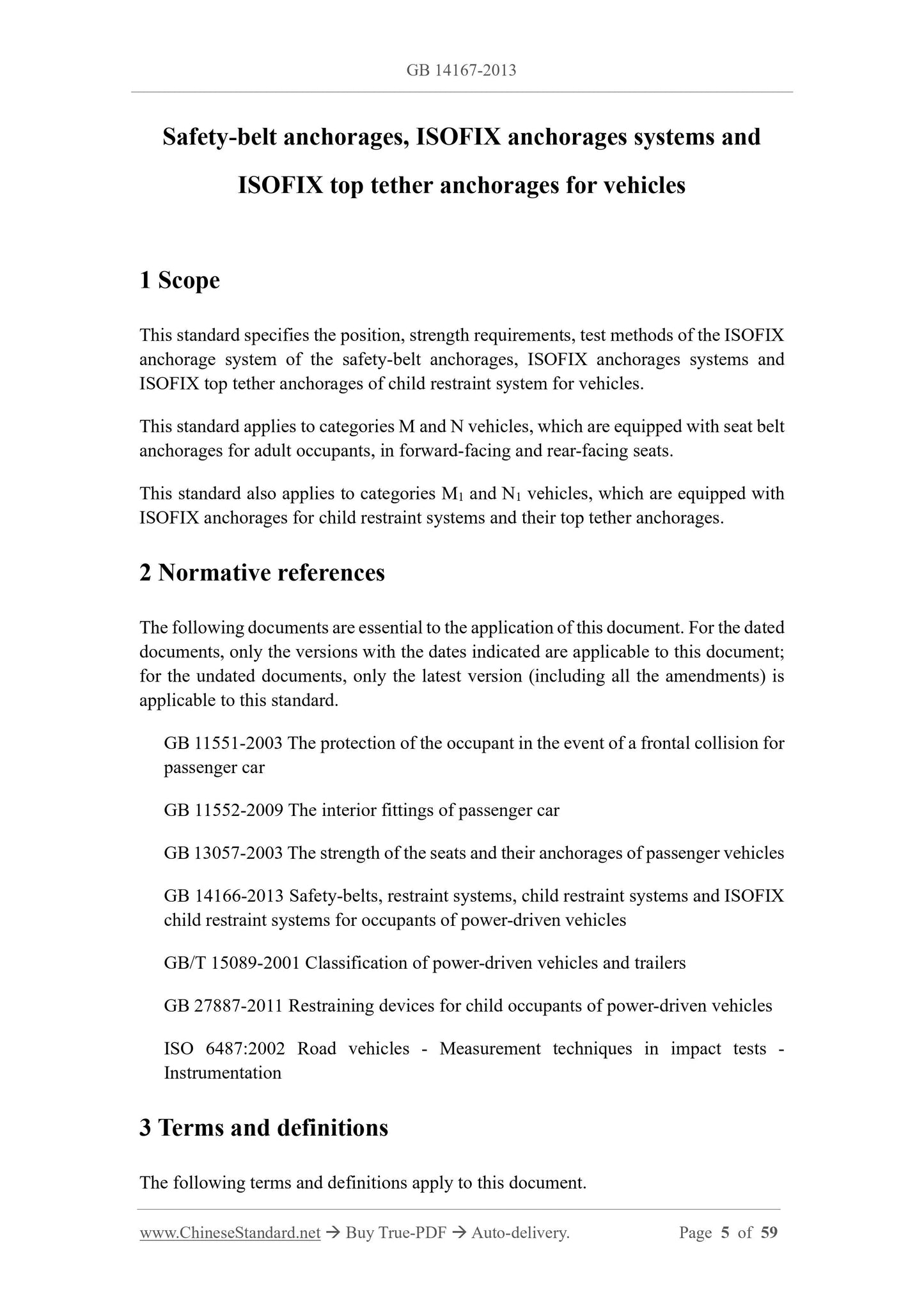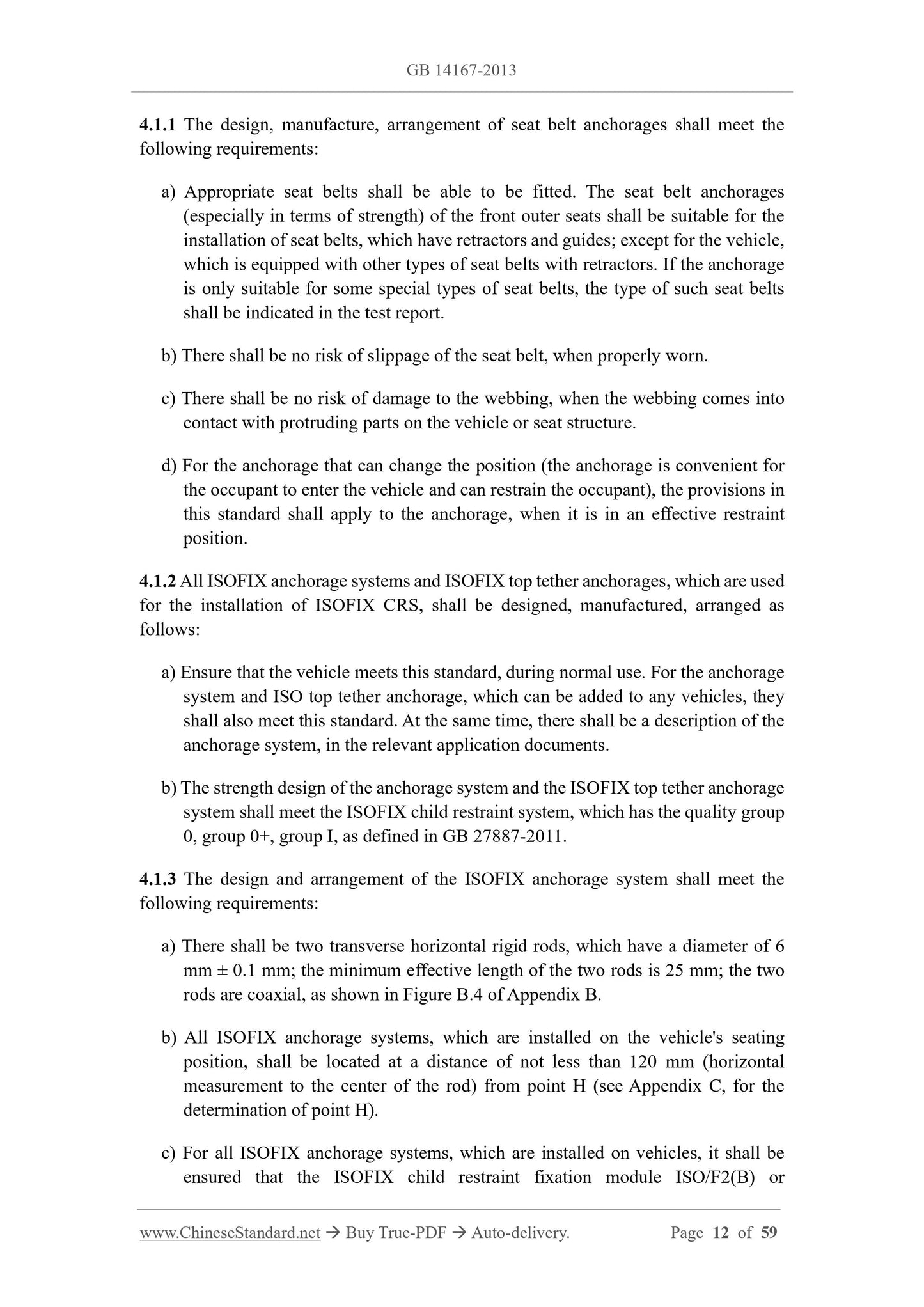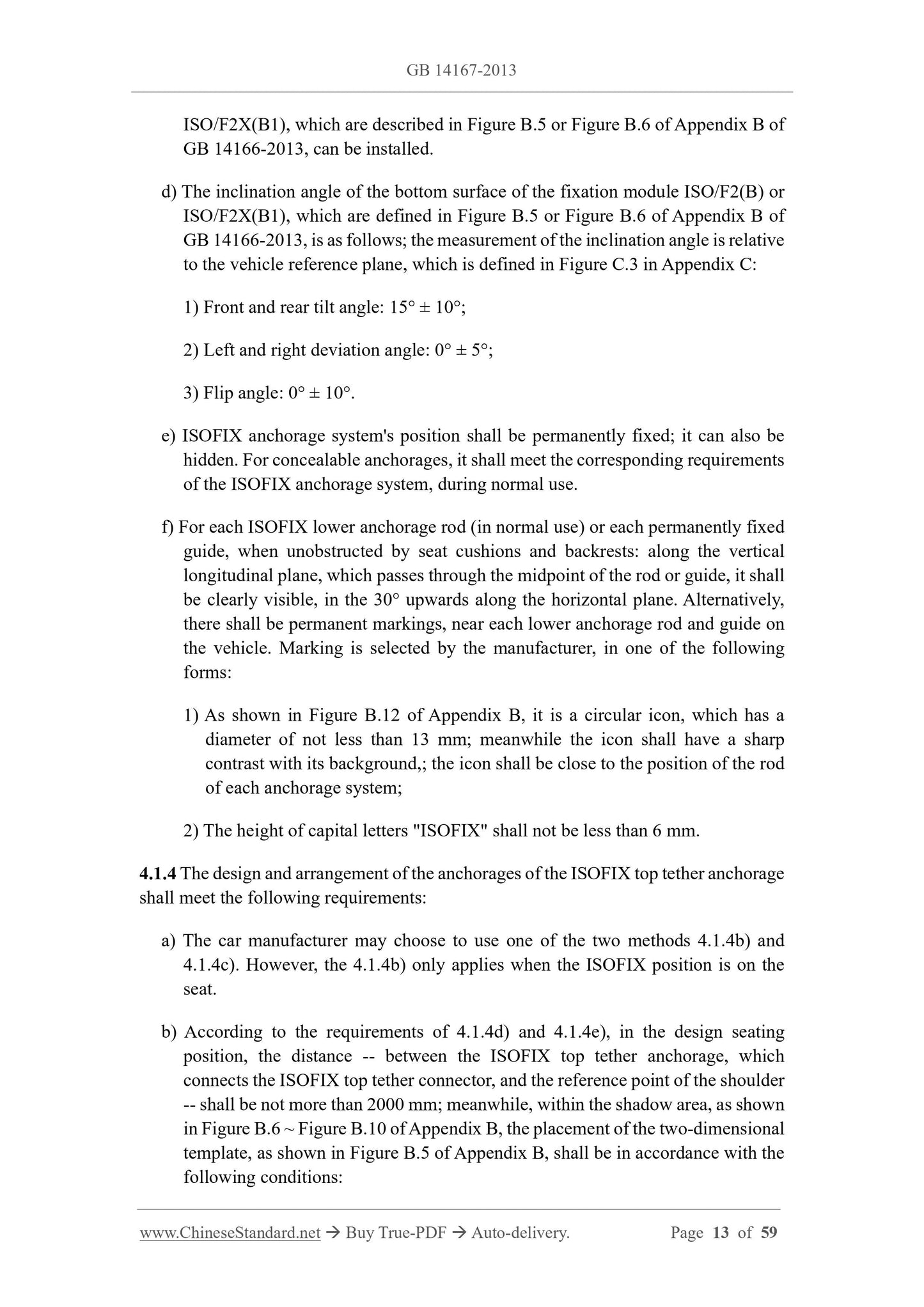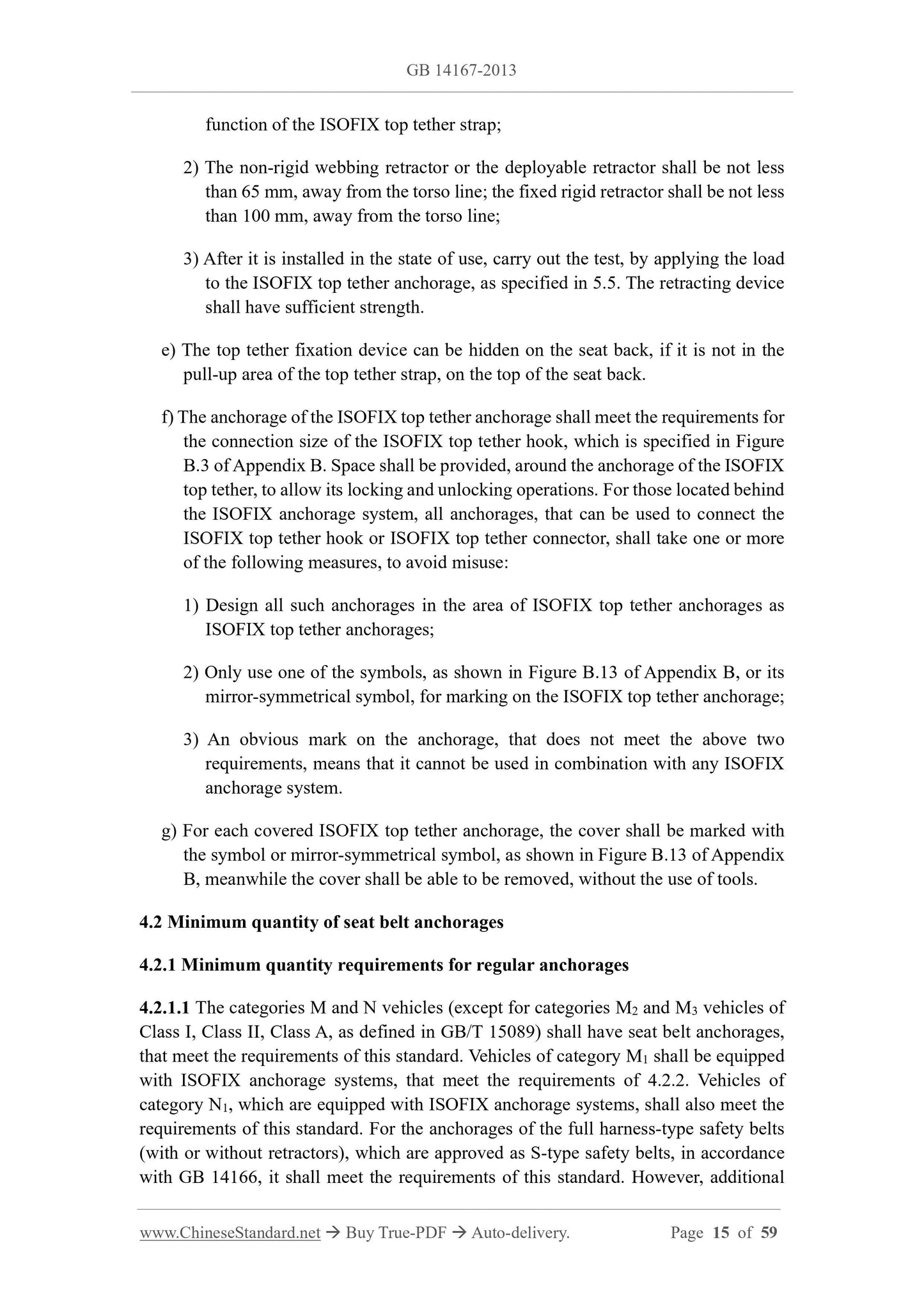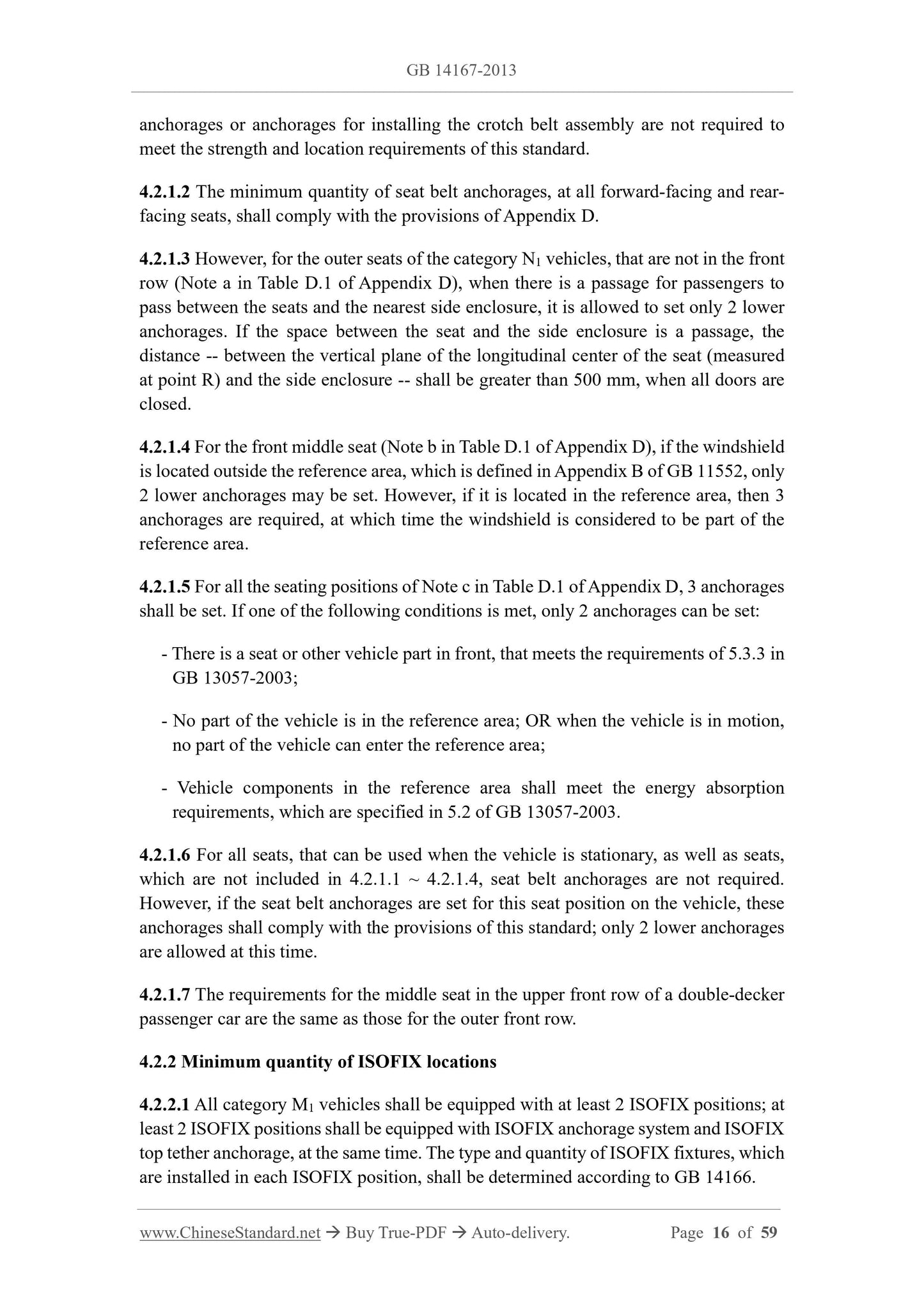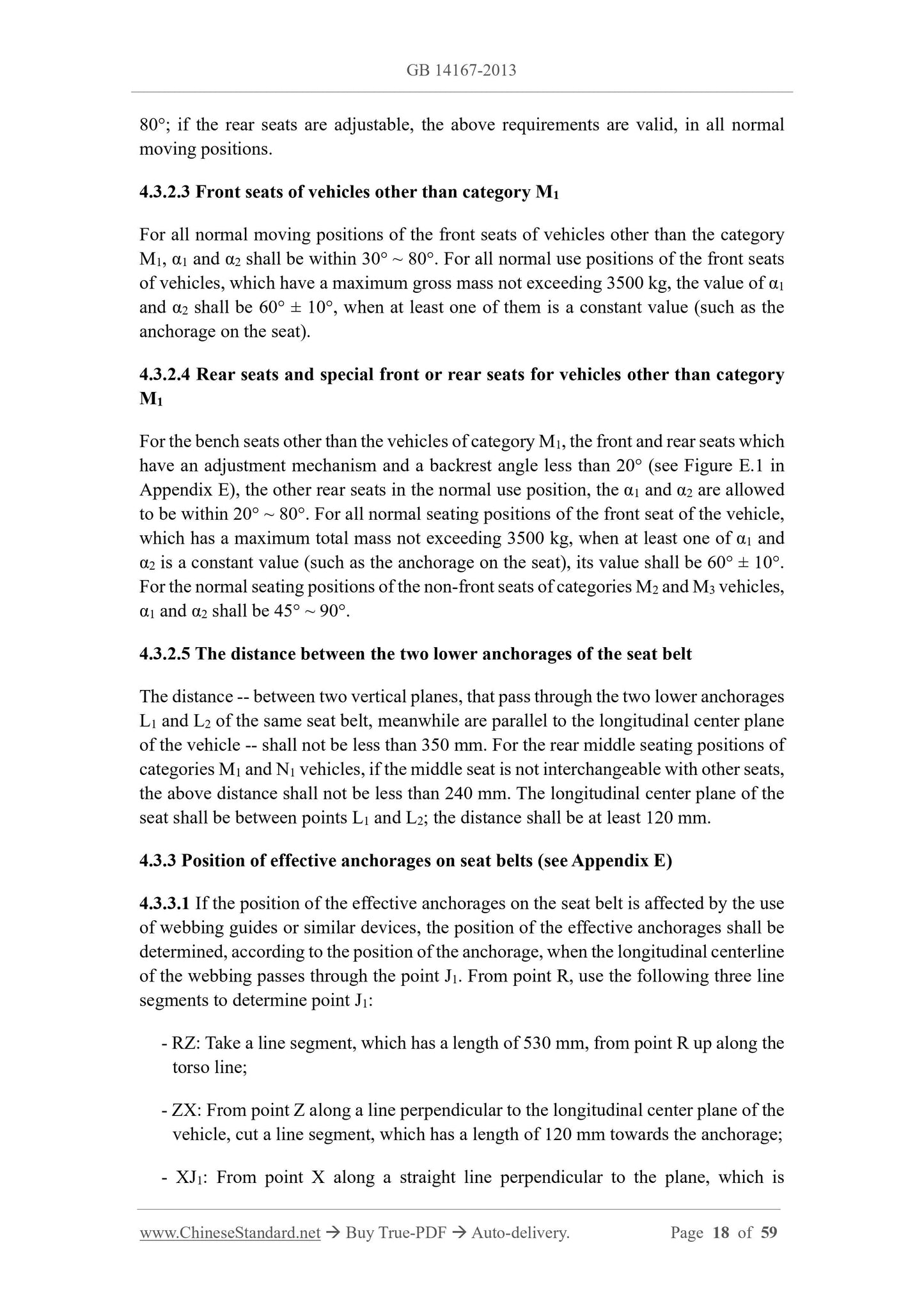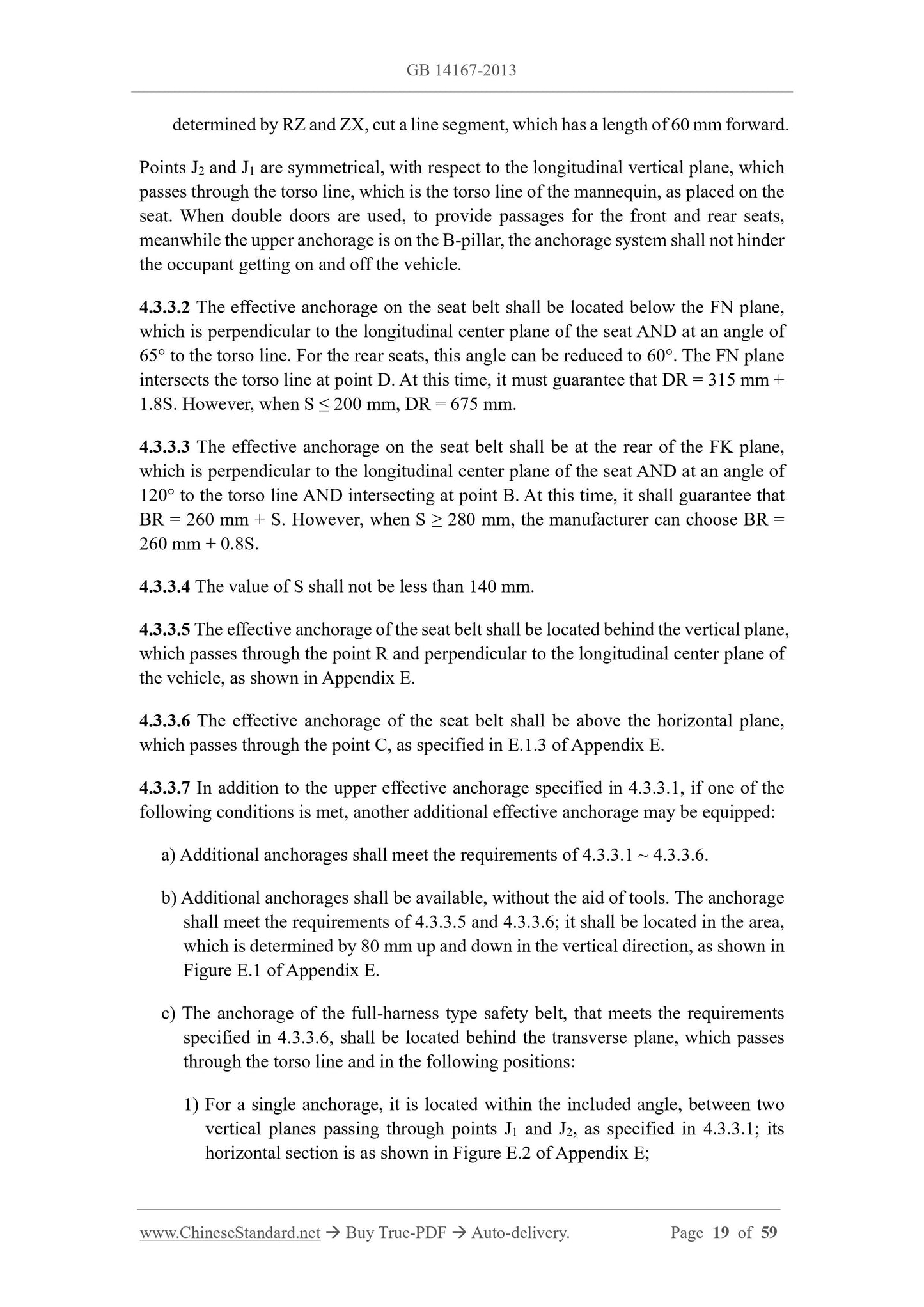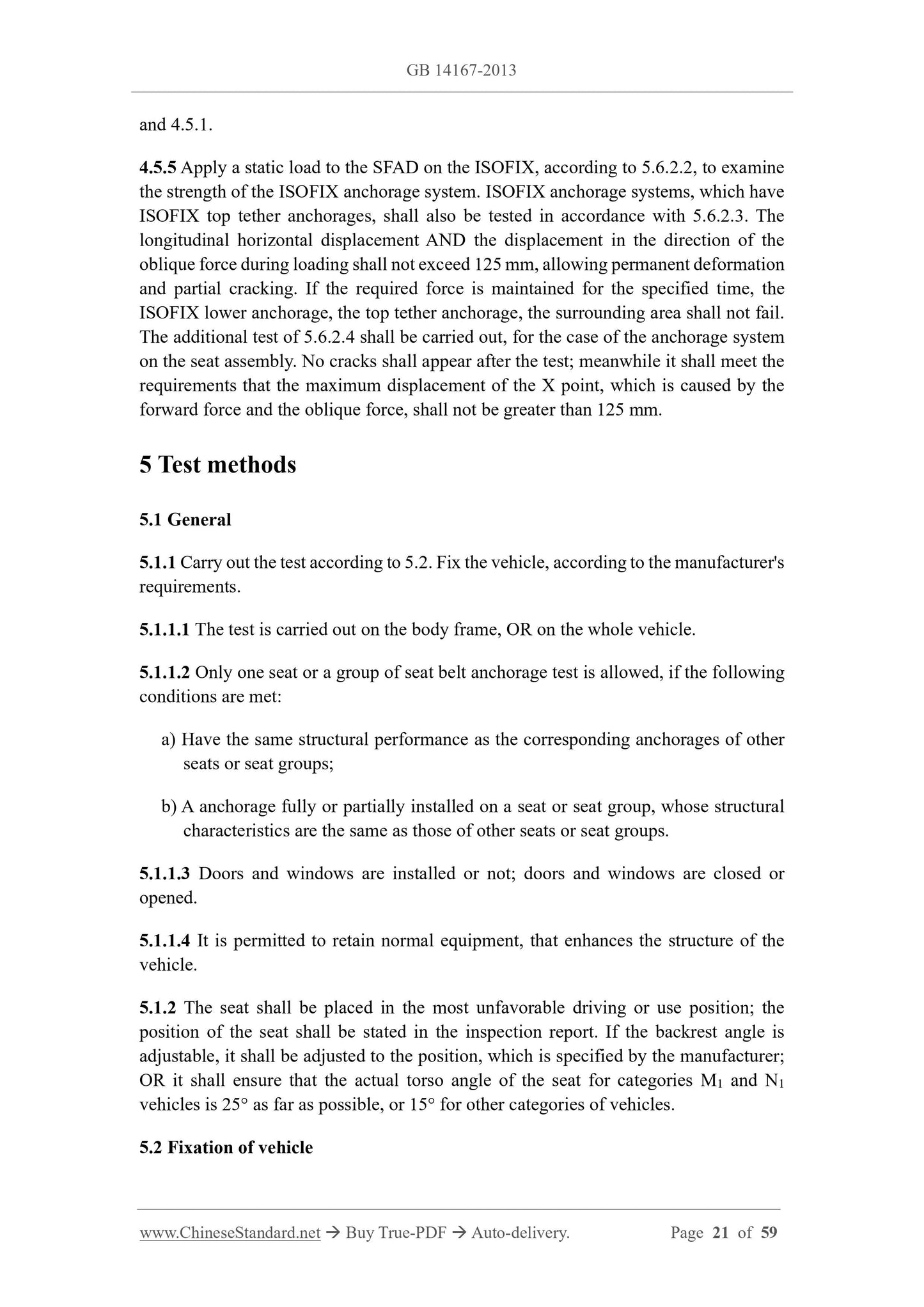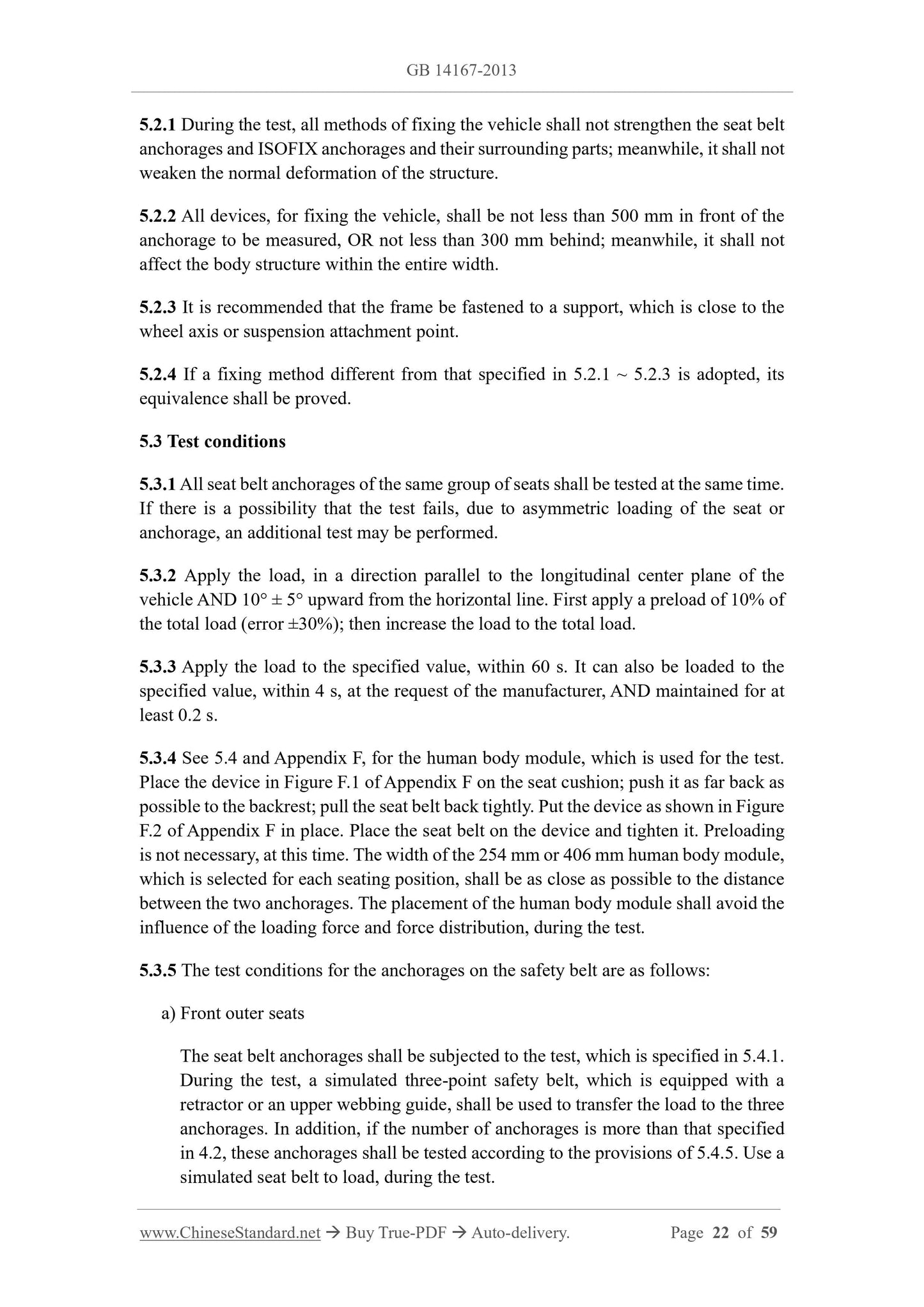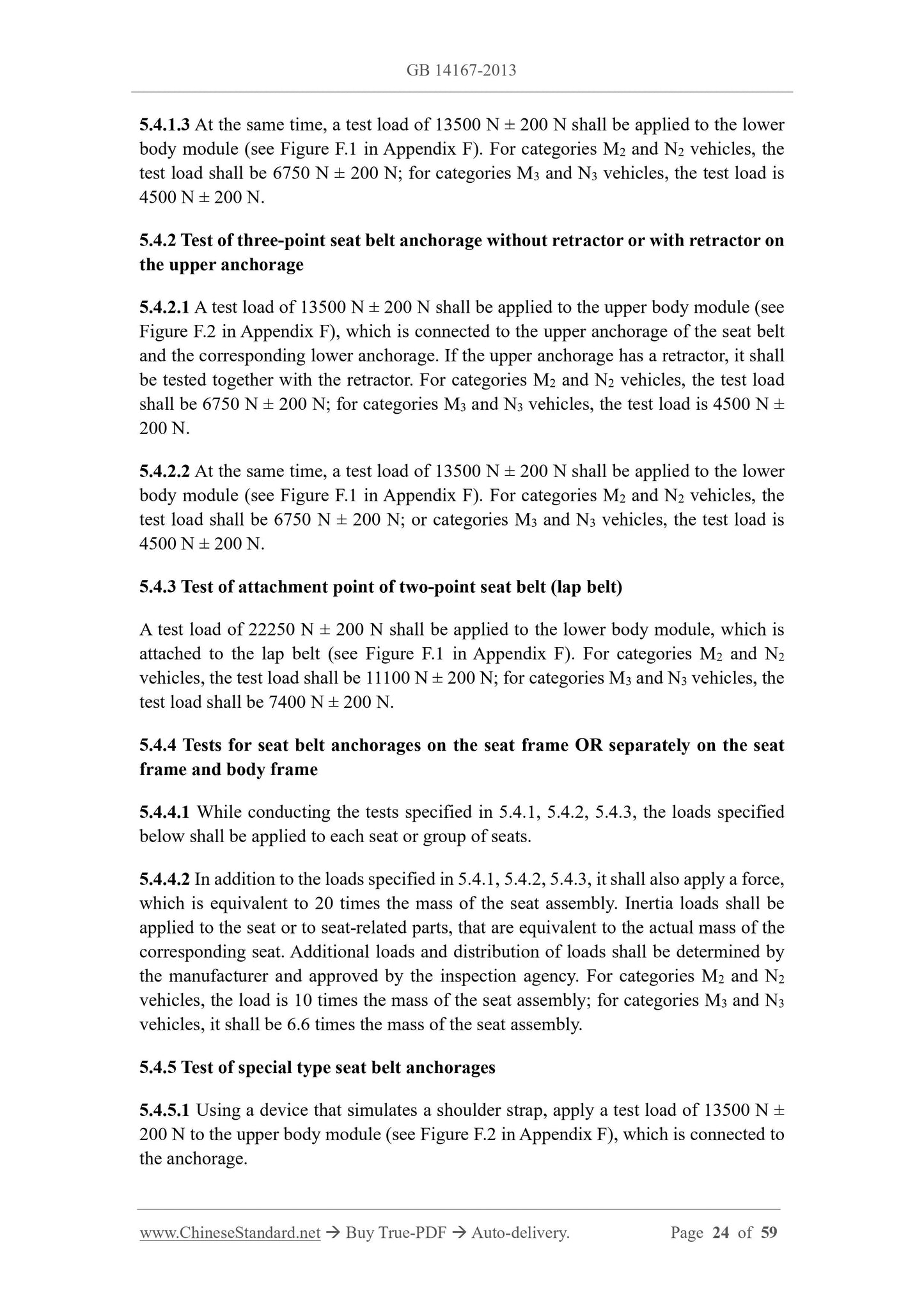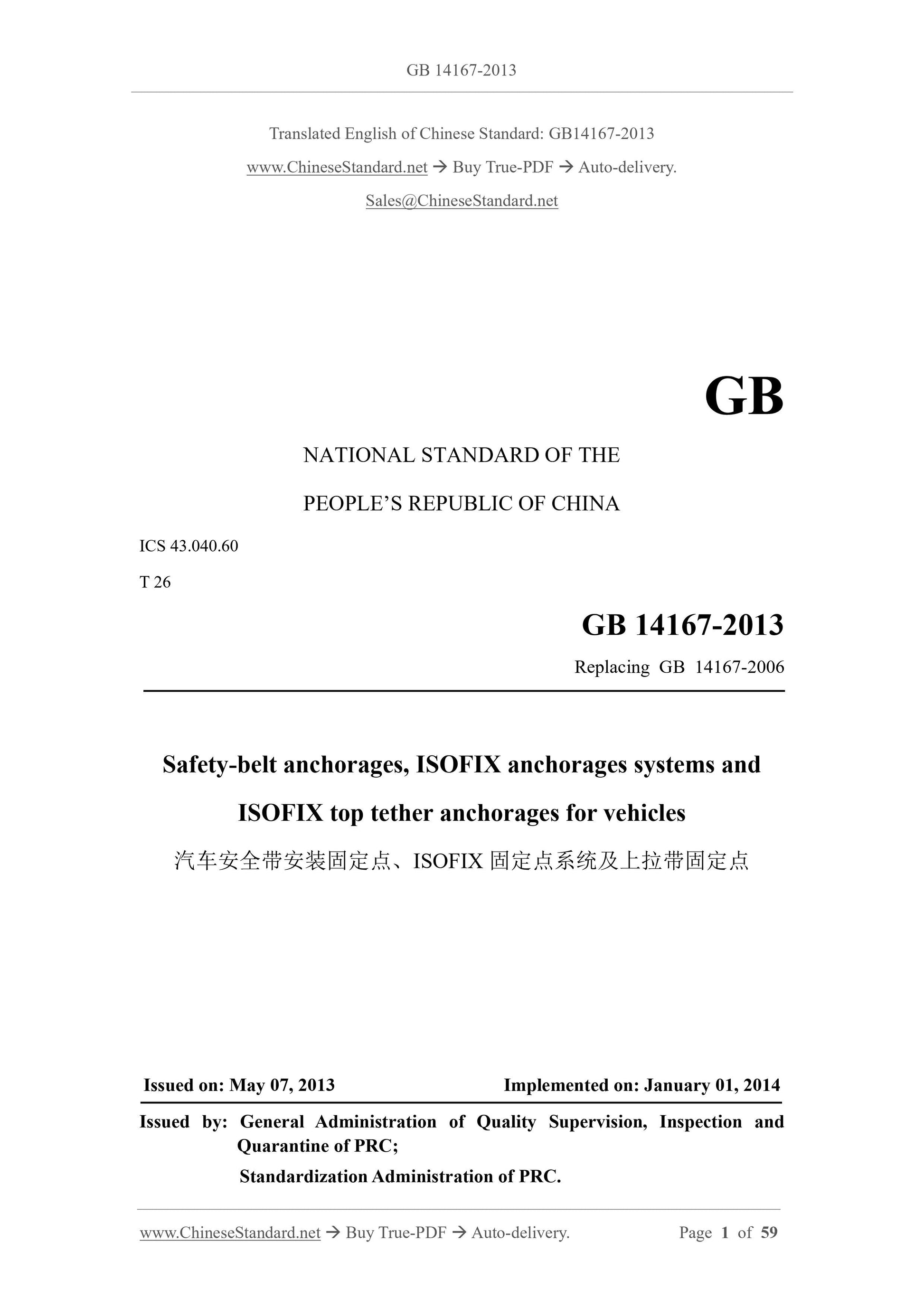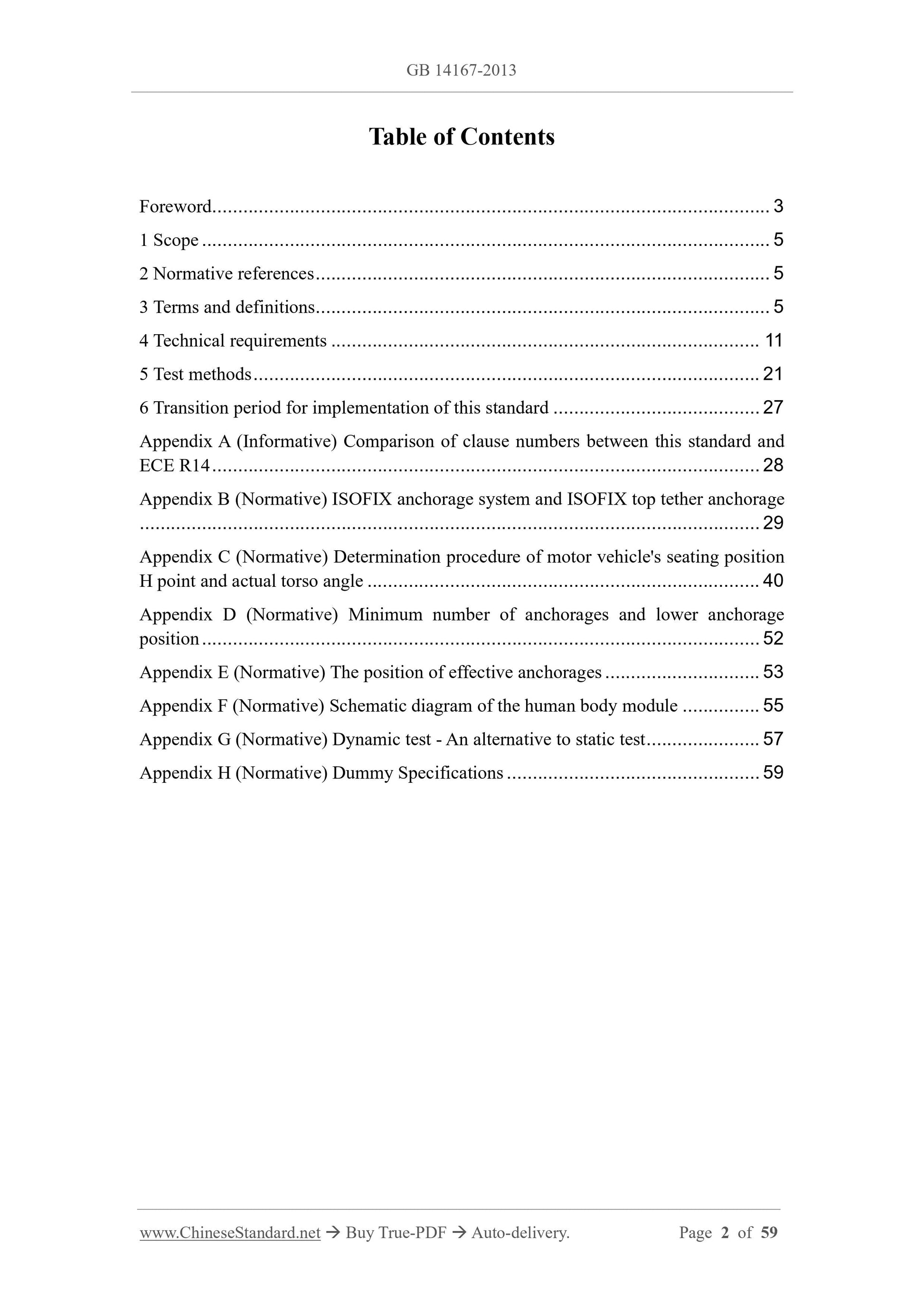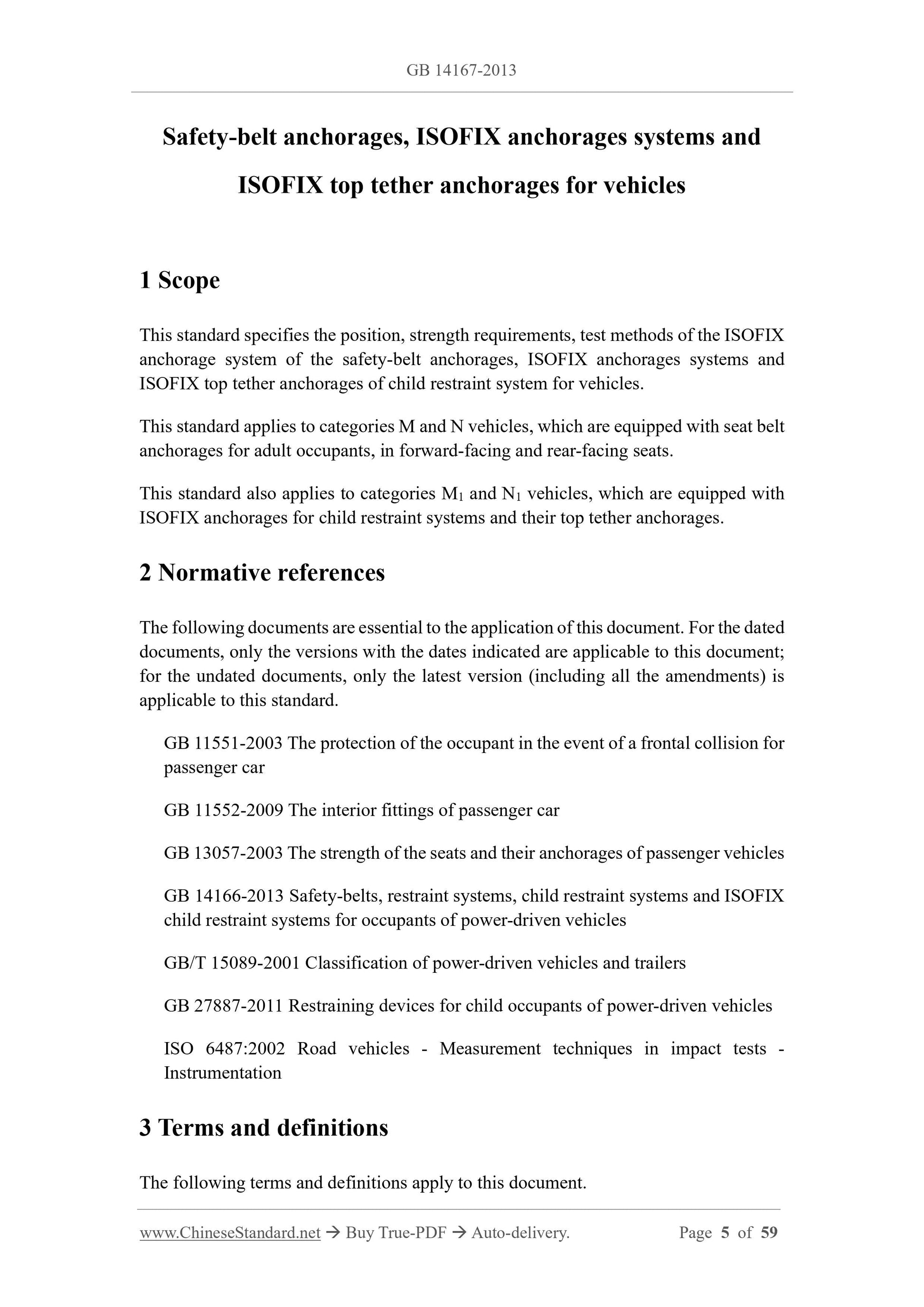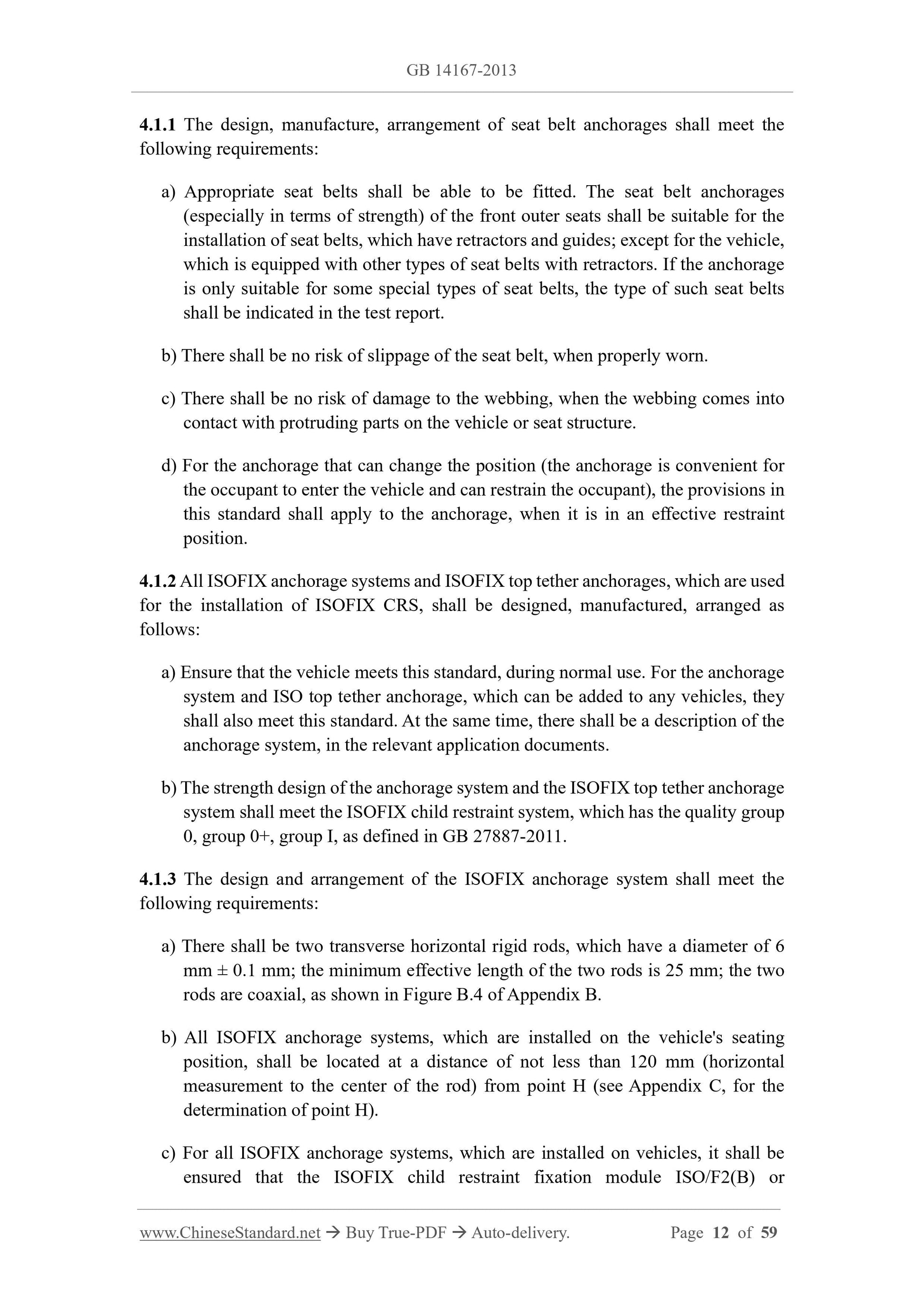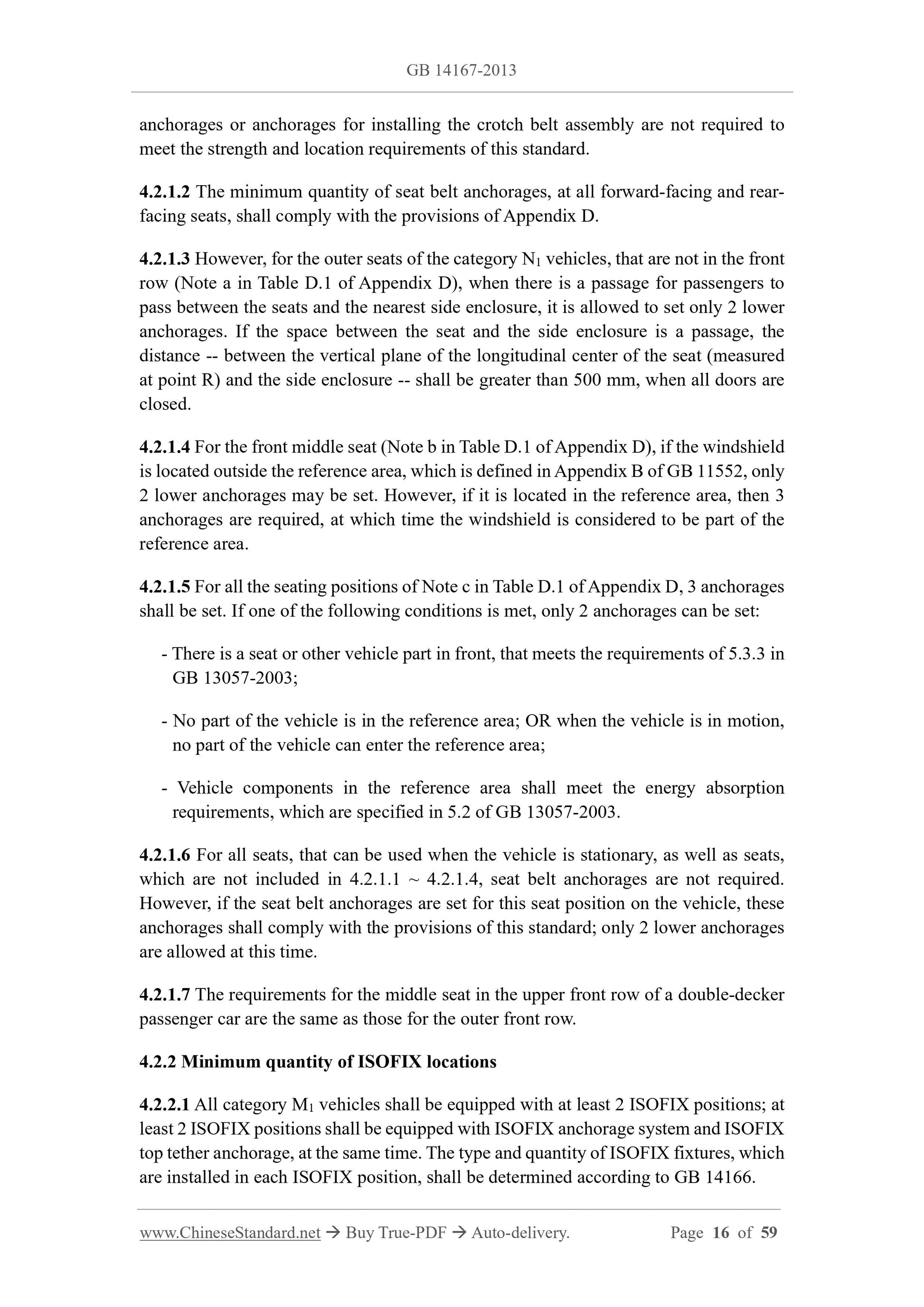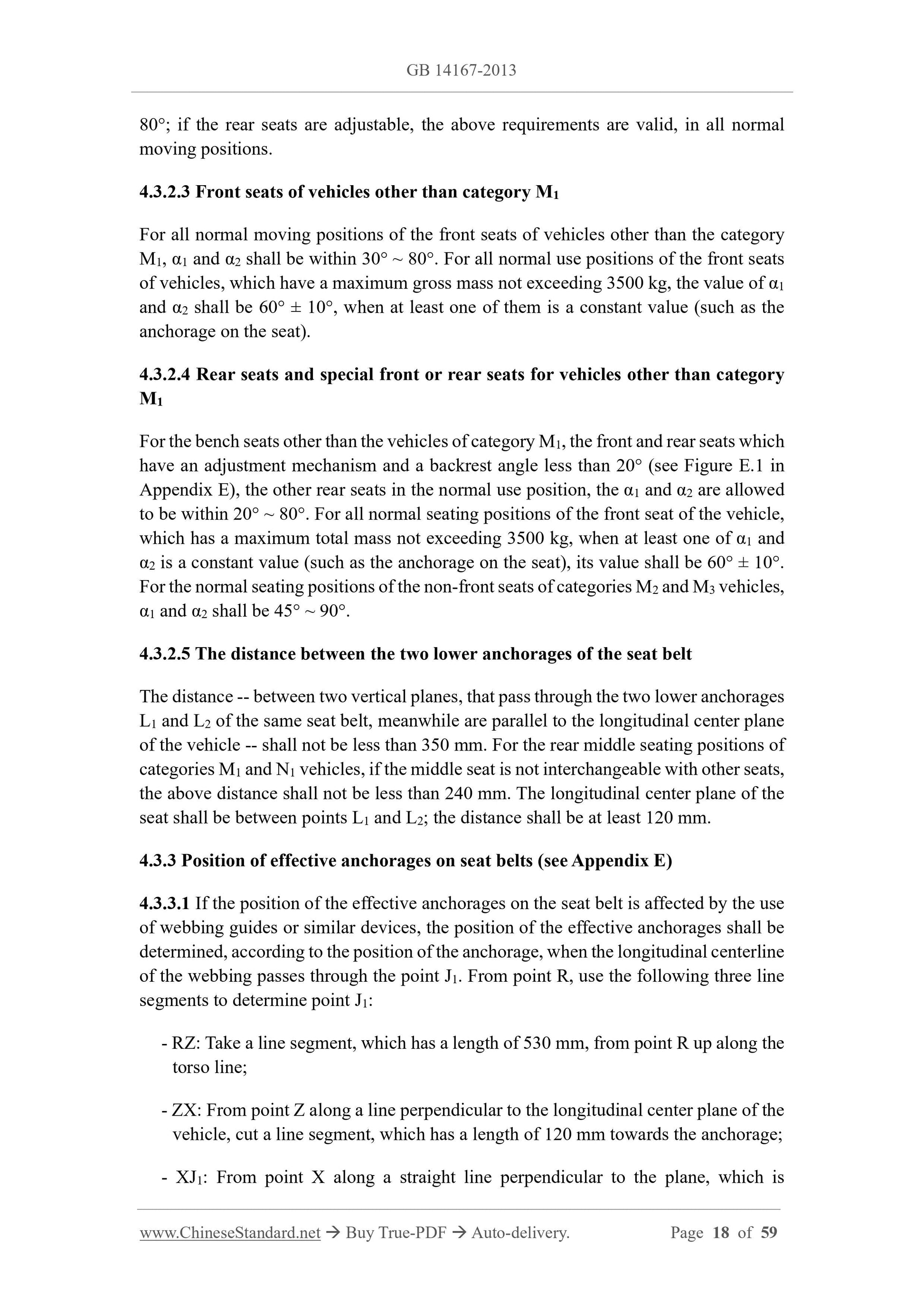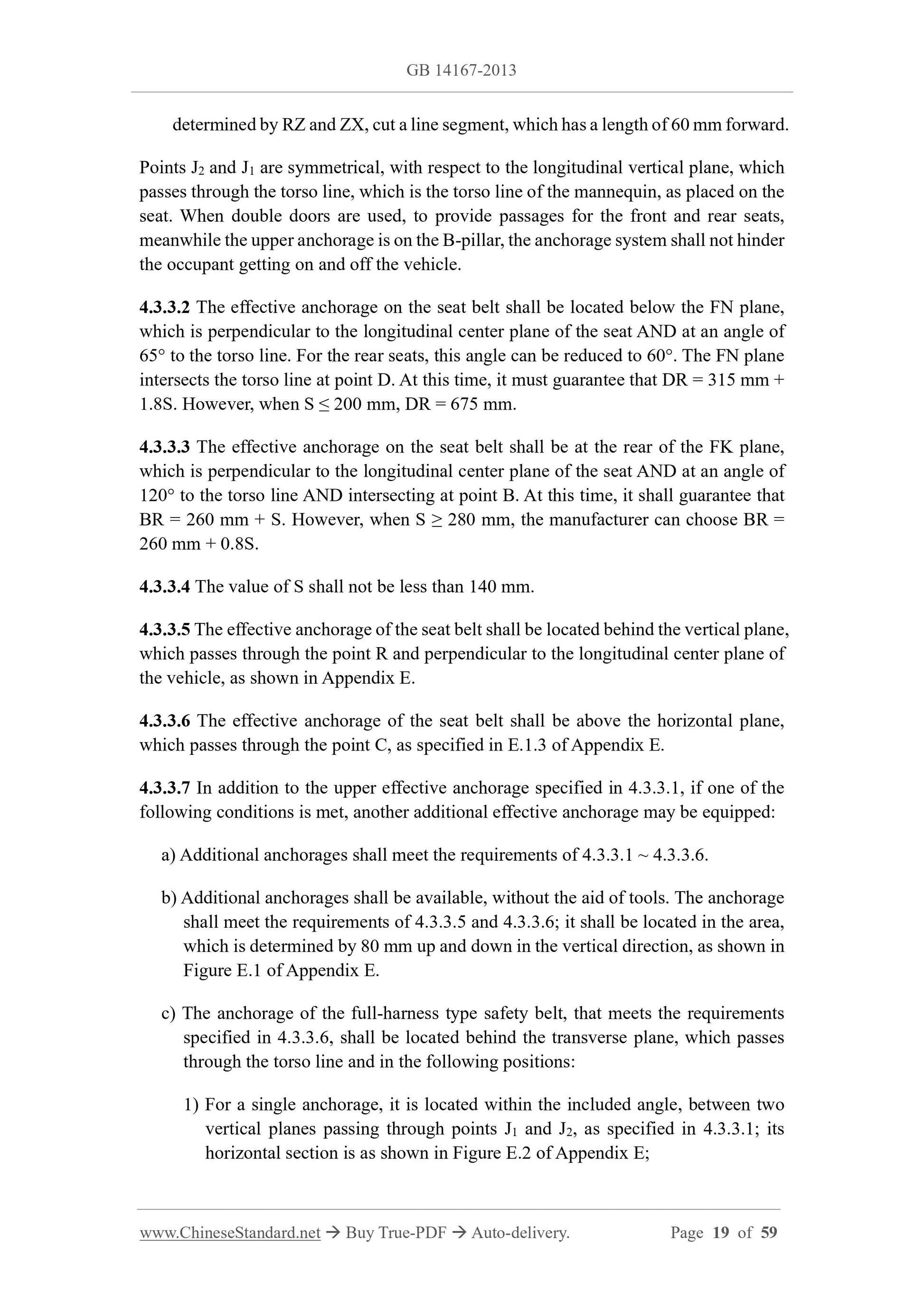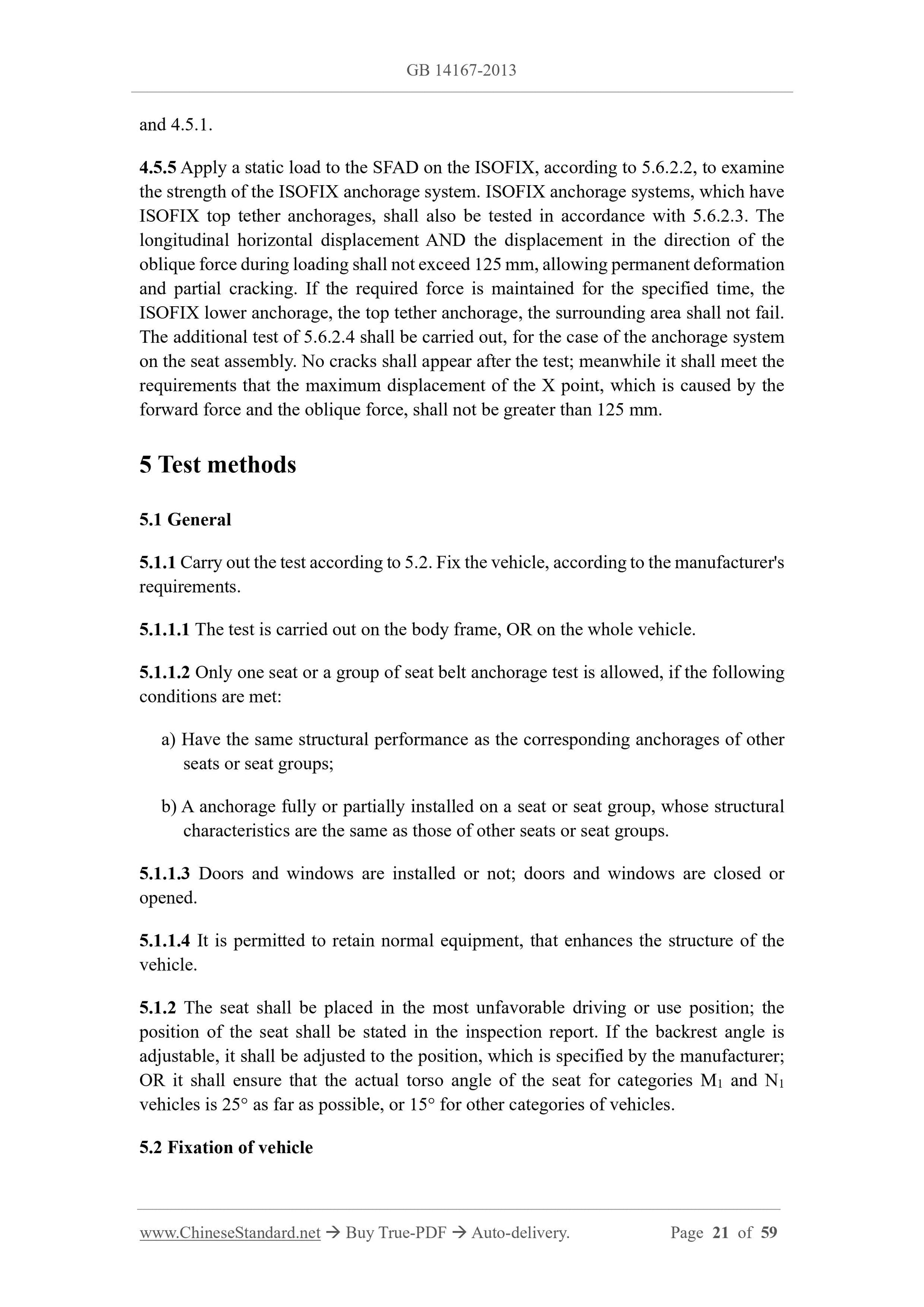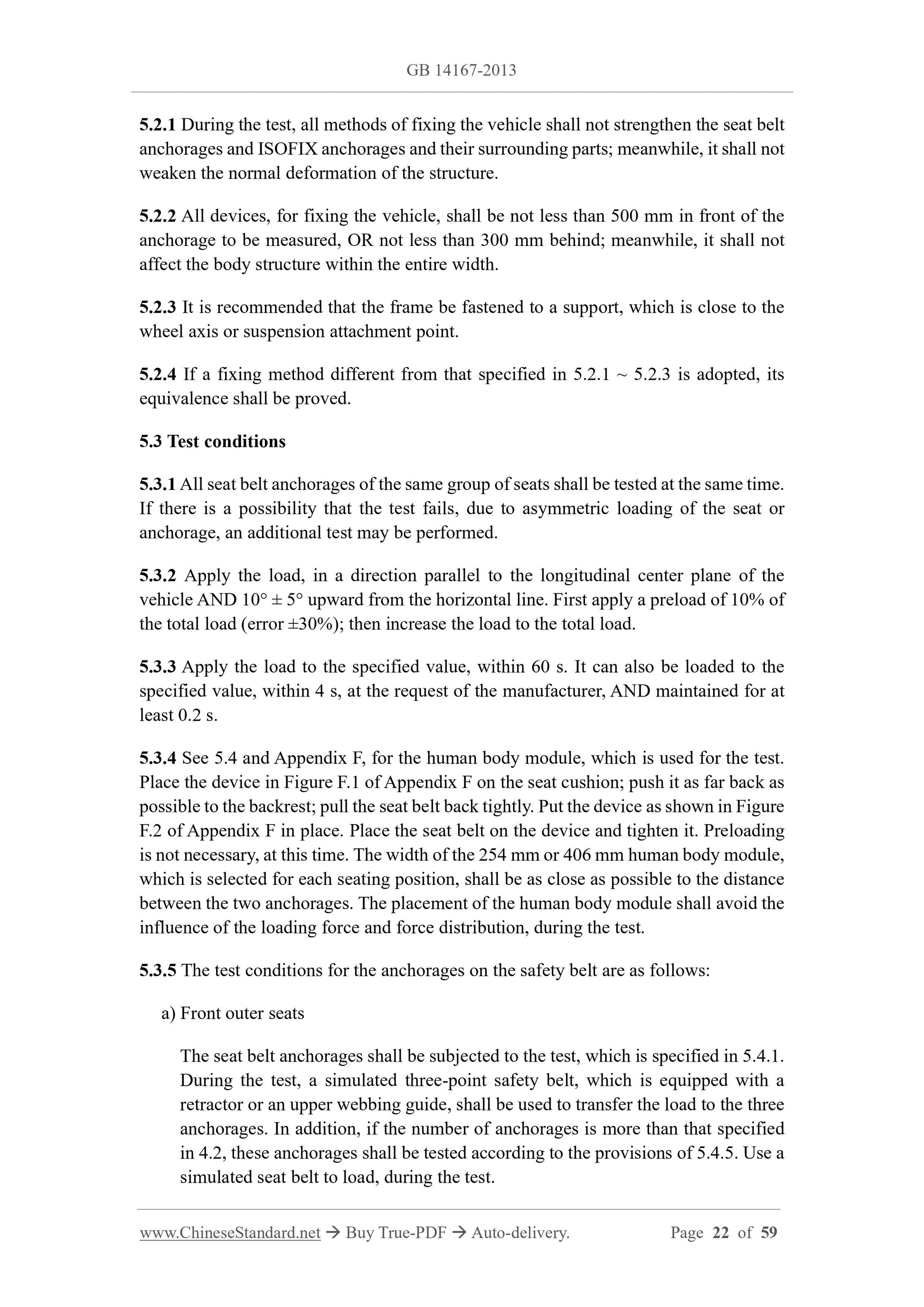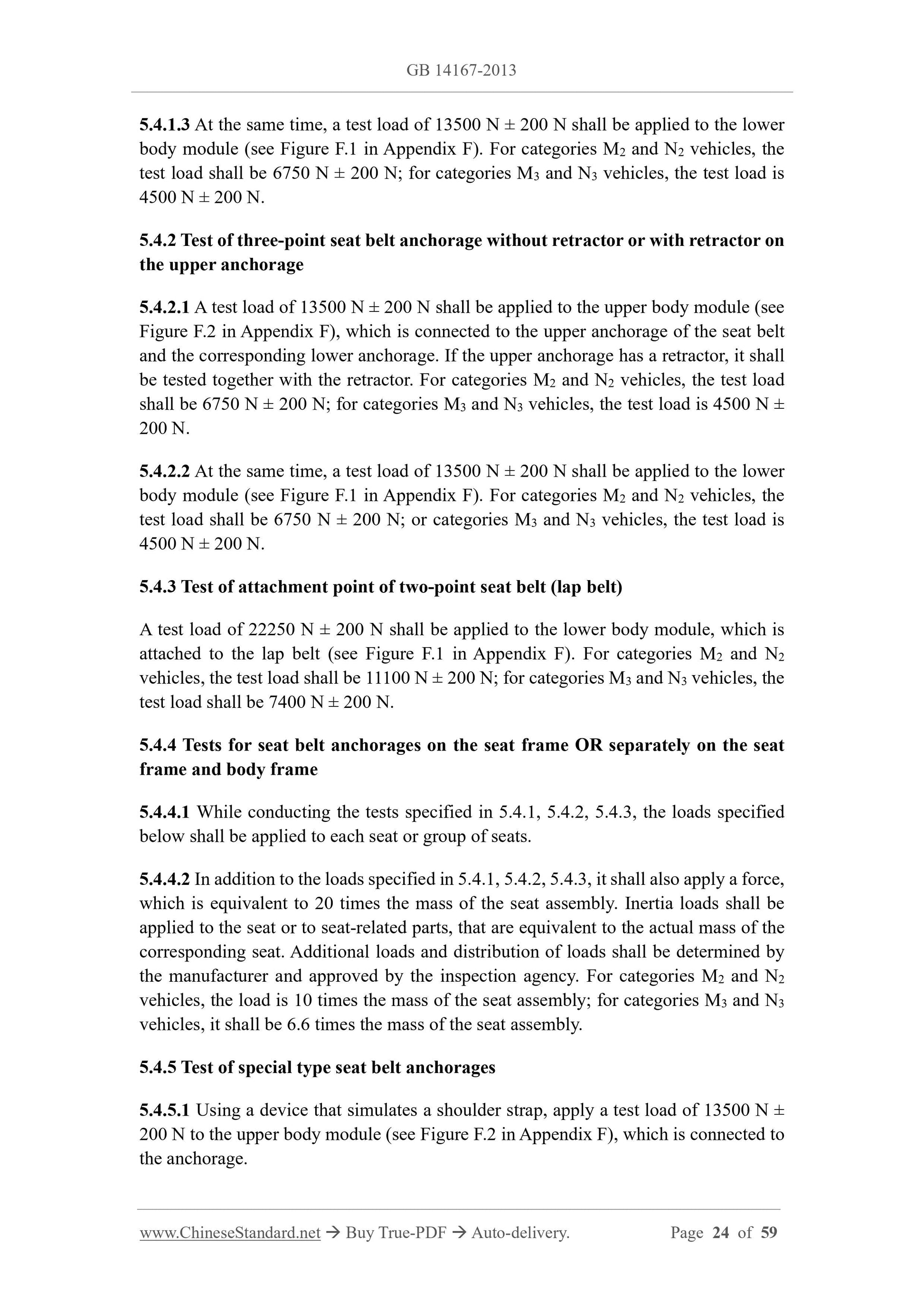1
/
of
12
PayPal, credit cards. Download editable-PDF & invoice In 1 second!
GB 14167-2013 English PDF
GB 14167-2013 English PDF
Regular price
$555.00
Regular price
Sale price
$555.00
Unit price
/
per
Shipping calculated at checkout.
Couldn't load pickup availability
GB 14167-2013: Safety-belt anchorages, ISOFIX anchorages systems and ISOFIX top tether anchorages for vehicles
Delivery: 9 seconds. Download (and Email) true-PDF + Invoice.
Newer version: (Replacing this standard) GB 14167-2024
Get Quotation: Click GB 14167-2013 (Self-service in 1-minute)
Historical versions (Master-website): GB 14167-2024
Preview True-PDF (Reload/Scroll-down if blank)
GB 14167-2013
NATIONAL STANDARD OF THE
PEOPLE’S REPUBLIC OF CHINA
ICS 43.040.60
T 26
Replacing GB 14167-2006
Safety-belt anchorages, ISOFIX anchorages systems and
ISOFIX top tether anchorages for vehicles
ISSUED ON: MAY 07, 2013
IMPLEMENTED ON: JANUARY 01, 2014
Issued by: General Administration of Quality Supervision, Inspection and
Quarantine of PRC;
Standardization Administration of PRC.
Table of Contents
Foreword ... 3
1 Scope ... 5
2 Normative references ... 5
3 Terms and definitions... 5
4 Technical requirements ... 11
5 Test methods ... 21
6 Transition period for implementation of this standard ... 27
Appendix A (Informative) Comparison of clause numbers between this standard and
ECE R14 ... 28
Appendix B (Normative) ISOFIX anchorage system and ISOFIX top tether anchorage
... 29
Appendix C (Normative) Determination procedure of motor vehicle's seating position
H point and actual torso angle ... 40
Appendix D (Normative) Minimum number of anchorages and lower anchorage
position ... 52
Appendix E (Normative) The position of effective anchorages ... 53
Appendix F (Normative) Schematic diagram of the human body module ... 55
Appendix G (Normative) Dynamic test - An alternative to static test ... 57
Appendix H (Normative) Dummy Specifications ... 59
Safety-belt anchorages, ISOFIX anchorages systems and
ISOFIX top tether anchorages for vehicles
1 Scope
This standard specifies the position, strength requirements, test methods of the ISOFIX
anchorage system of the safety-belt anchorages, ISOFIX anchorages systems and
ISOFIX top tether anchorages of child restraint system for vehicles.
This standard applies to categories M and N vehicles, which are equipped with seat belt
anchorages for adult occupants, in forward-facing and rear-facing seats.
This standard also applies to categories M1 and N1 vehicles, which are equipped with
ISOFIX anchorages for child restraint systems and their top tether anchorages.
2 Normative references
The following documents are essential to the application of this document. For the dated
documents, only the versions with the dates indicated are applicable to this document;
for the undated documents, only the latest version (including all the amendments) is
applicable to this standard.
GB 11551-2003 The protection of the occupant in the event of a frontal collision for
passenger car
GB 11552-2009 The interior fittings of passenger car
GB 13057-2003 The strength of the seats and their anchorages of passenger vehicles
GB 14166-2013 Safety-belts, restraint systems, child restraint systems and ISOFIX
child restraint systems for occupants of power-driven vehicles
GB/T 15089-2001 Classification of power-driven vehicles and trailers
GB 27887-2011 Restraining devices for child occupants of power-driven vehicles
ISO 6487:2002 Road vehicles - Measurement techniques in impact tests -
Instrumentation
3 Terms and definitions
The following terms and definitions apply to this document.
4.1.1 The design, manufacture, arrangement of seat belt anchorages shall meet the
following requirements:
a) Appropriate seat belts shall be able to be fitted. The seat belt anchorages
(especially in terms of strength) of the front outer seats shall be suitable for the
installation of seat belts, which have retractors and guides; except for the vehicle,
which is equipped with other types of seat belts with retractors. If the anchorage
is only suitable for some special types of seat belts, the type of such seat belts
shall be indicated in the test report.
b) There shall be no risk of slippage of the seat belt, when properly worn.
c) There shall be no risk of damage to the webbing, when the webbing comes into
contact with protruding parts on the vehicle or seat structure.
d) For the anchorage that can change the position (the anchorage is convenient for
the occupant to enter the vehicle and can restrain the occupant), the provisions in
this standard shall apply to the anchorage, when it is in an effective restraint
position.
4.1.2 All ISOFIX anchorage systems and ISOFIX top tether anchorages, which are used
for the installation of ISOFIX CRS, shall be designed, manufactured, arranged as
follows:
a) Ensure that the vehicle meets this standard, during normal use. For the anchorage
system and ISO top tether anchorage, which can be added to any vehicles, they
shall also meet this standard. At the same time, there shall be a description of the
anchorage system, in the relevant application documents.
b) The strength design of the anchorage system and the ISOFIX top tether anchorage
system shall meet the ISOFIX child restraint system, which has the quality group
0, group 0+, group I, as defined in GB 27887-2011.
4.1.3 The design and arrangement of the ISOFIX anchorage system shall meet the
following requirements:
a) There shall be two transverse horizontal rigid rods, which have a diameter of 6
mm ± 0.1 mm; the minimum effective length of the two rods is 25 mm; the two
rods are coaxial, as shown in Figure B.4 of Appendix B.
b) All ISOFIX anchorage systems, which are installed on the vehicle's seating
position, shall be located at a distance of not less than 120 mm (horizontal
measurement to the center of the rod) from point H (see Appendix C, for the
determination of point H).
c) For all ISOFIX anchorage systems, which are installed on vehicles, it shall be
ensured that the ISOFIX child restraint fixation module ISO/F2(B) or
ISO/F2X(B1), which are described in Figure B.5 or Figure B.6 of Appendix B of
GB 14166-2013, can be installed.
d) The inclination angle of the bottom surface of the fixation module ISO/F2(B) or
ISO/F2X(B1), which are defined in Figure B.5 or Figure B.6 of Appendix B of
GB 14166-2013, is as follows; the measurement of the inclination angle is relative
to the vehicle reference plane, which is defined in Figure C.3 in Appendix C:
1) Front and rear tilt angle: 15° ± 10°;
2) Left and right deviation angle: 0° ± 5°;
3) Flip angle: 0° ± 10°.
e) ISOFIX anchorage system's position shall be permanently fixed; it can also be
hidden. For concealable anchorages, it shall meet the corresponding requirements
of the ISOFIX anchorage system, during normal use.
f) For each ISOFIX lower anchorage rod (in normal use) or each permanently fixed
guide, when unobstructed by seat cushions and backrests: along the vertical
longitudinal plane, which passes through the midpoint of the rod or guide, it shall
be clearly visible, in the 30° upwards along the horizontal plane. Alternatively,
there shall be permanent markings, near each lower anchorage rod and guide on
the vehicle. Marking is selected by the manufacturer, in one of the following
forms:
1) As shown in Figure B.12 of Appendix B, it is a circular icon, which has a
diameter of not less than 13 mm; meanwhile the icon shall have a sharp
contrast with its background,; the icon shall be close to the position of the rod
of each anchorage system;
2) The height of capital letters "ISOFIX" shall not be less than 6 mm.
4.1.4 The design and arrangement of the anchorages of the ISOFIX top tether anchorage
shall meet the following requirements:
a) The car manufacturer may choose to use one of the two methods 4.1.4b) and
4.1.4c). However, the 4.1.4b) only applies when the ISOFIX position is on the
seat.
b) According to the requirements of 4.1.4d) and 4.1.4e), in the design seating
position, the distance -- between the ISOFIX top tether anchorage, which
connects the ISOFIX top tether connector, and the reference point of the shoulder
-- shall be not more than 2000 mm; meanwhile, within the shadow area, as shown
in Figure B.6 ~ Figure B.10 of Appendix B, the placement of the two-dimensional
template, as shown in Figure B.5 of Appendix B, shall be in accordance with the
following conditions:
function of the ISOFIX top tether strap;
2) The non-rigid webbing retractor or the deployable retractor shall be not less
than 65 mm, away from the torso line; the fixed rigid retractor shall be not less
than 100 mm, away from the torso line;
3) After it is installed in the state of use, carry out the test, by applying the load
to the ISOFIX top tether anchorage, as specified in 5.5. The retracting device
shall have sufficient strength.
e) The top tether fixation device can be hidden on the seat back, if it is not in the
pull-up area of the top tether strap, on the top of the seat back.
f) The anchorage of the ISOFIX top tether anchorage shall meet the requirements for
the connection size of the ISOFIX top tether hook, which is specified in Figure
B.3 of Appendix B. Space shall be provided, around the anchorage of the ISOFIX
top tether, to allow its locking and unlocking operations. For those located behind
the ISOFIX anchorage system, all anchorages, that can be used to connect the
ISOFIX top tether hook or ISOFIX top tether connector, shall take one or more
of the following measures, to avoid misuse:
1) Design all such anchorages in the area of ISOFIX top tether anchorages as
ISOFIX top tether anchorages;
2) Only use one of the symbols, as shown in Figure B.13 of Appendix B, or its
mirror-symmetrical symbol, for marking on the ISOFIX top tether anchorage;
3) An obvious mark on the anchorage, that does not meet the above two
requirements, means that it cannot be used in combination with any ISOFIX
anchorage system.
g) For each covered ISOFIX top tether anchorage, the cover shall be marked with
the symbol or mirror-symmetrical symbol, as shown in Figure B.13 of Appendix
B, meanwhile the cover shall be able to be removed, without the use of tools.
4.2 Minimum quantity of seat belt anchorages
4.2.1 Minimum quantity requirements for regular anchorages
4.2.1.1 The categories M and N vehicles (except for categories M2 and M3 vehicles of
Class I, Class II, Class A, as defined in GB/T 15089) shall have seat belt anchorages,
that meet the requirements of this standard. Vehicles of category M1 shall be equipped
with ISOFIX anchorage systems, that meet the requirements of 4.2.2. Vehicles of
category N1, which are equipped with ISOFIX anchorage systems, shall also meet the
requirements of this standard. For the anchorages of the full harness-type safety belts
(with or without retractors), which are approved as S-type safety belts, in accordance
with GB 14166, it shall meet the requirements of this standard. However, additional
anchorages or anchorages for installing the crotch belt assembly are not required to
meet the strength and location requirements of this standard.
4.2.1.2 The minimum quantity of seat belt anchorages, at all forward-facing and rear-
facing seats, shall comply with the provisions of Appendix D.
4.2.1.3 However, for the outer seats of the category N1 vehicles, that are not in the front
row (Note a in Table D.1 of Appendix D), when there is a passage for passengers to
pass between the seats and the nearest side enclosure, it is allowed to set only 2 lower
anchorages. If the space between the seat and the side enclosure is a passage, the
distance -- between the vertical plane of the longitudinal center of the seat (measured
at point R) and the side enclosure -- shall be greater than 500 mm, when all doors are
closed.
4.2.1.4 For the front middle seat (Note b in Table D.1 of Appendix D), if the windshield
is located outside the reference area, which is defined in Appendix B of GB 11552, only
2 lower anchorages may be set. However, if it is located in the reference area, then 3
anchorages are required, at which time the windshield is considered to be part of the
reference area.
4.2.1.5 For all the seating positions of Note c in Table D.1 of Appendix D, 3 anchorages
shall be set. If one of the following conditions is met, only 2 anchorages can be set:
- There is a seat or other vehicle part in front, that meets the requirements of 5.3.3 in
GB 13057-2003;
- No part of the vehicle is in the reference area; OR when the vehicle is in motion,
no part of the vehicle can enter the reference area;
- Vehicle components in the reference area shall meet the energy absorption
requirements, which are specified in 5.2 of GB 13057-2003.
4.2.1.6 For all seats, that can be used when the vehicle is stationary, as well as seats,
which are not included in 4.2.1.1 ~ 4.2.1.4, seat belt anchorages are not required.
However, if the seat belt anchorages are set for this seat position on the vehicle, these
anchorages shall comply with the provisions of this standard; only 2 lower anchorages
are allowed at this time.
4.2.1.7 The requirements for the middle seat in the upper front row of a double-decker
passenger car are the same as those for the outer front row.
4.2.2 Minimum quantity of ISOFIX locations
4.2.2.1 All category M1 vehicles shall be equipped with at least 2 ISOFIX positions; at
least 2 ISOFIX positions shall be equipped with ISOFIX anchorage system and ISOFIX
top tether anchorage, at the same time. The type and quantity of ISOFIX fixtures, which
are installed in each ISOFIX position, shall be determined according to GB 14166.
80°; if the rear seats are adjustable, the above requirements are valid, in all normal
moving positions.
4.3.2.3 Front seats of vehicles other than category M1
For all normal moving positions of the front seats of vehicles other than the category
M1, α1 and α2 shall be within 30° ~ 80°. For all normal use positions of the front seats
of vehicles, which have a maximum gross mass not exceeding 3500 kg, the value of α1
and α2 shall be 60° ± 10°, when at least one of them is a constant value (such as the
anchorage on the seat).
4.3.2.4 Rear seats and special front or rear seats for vehicles other than category
M1
For the bench seats other than the vehicles of category M1, the front and rear seats which
have an adjustment mechanism and a backrest angle less than 20° (see Figure E.1 in
Appendix E), the other rear seats in the normal use position, the α1 and α2 are allowed
to be within 20° ~ 80°. For all normal seating posi...
Delivery: 9 seconds. Download (and Email) true-PDF + Invoice.
Newer version: (Replacing this standard) GB 14167-2024
Get Quotation: Click GB 14167-2013 (Self-service in 1-minute)
Historical versions (Master-website): GB 14167-2024
Preview True-PDF (Reload/Scroll-down if blank)
GB 14167-2013
NATIONAL STANDARD OF THE
PEOPLE’S REPUBLIC OF CHINA
ICS 43.040.60
T 26
Replacing GB 14167-2006
Safety-belt anchorages, ISOFIX anchorages systems and
ISOFIX top tether anchorages for vehicles
ISSUED ON: MAY 07, 2013
IMPLEMENTED ON: JANUARY 01, 2014
Issued by: General Administration of Quality Supervision, Inspection and
Quarantine of PRC;
Standardization Administration of PRC.
Table of Contents
Foreword ... 3
1 Scope ... 5
2 Normative references ... 5
3 Terms and definitions... 5
4 Technical requirements ... 11
5 Test methods ... 21
6 Transition period for implementation of this standard ... 27
Appendix A (Informative) Comparison of clause numbers between this standard and
ECE R14 ... 28
Appendix B (Normative) ISOFIX anchorage system and ISOFIX top tether anchorage
... 29
Appendix C (Normative) Determination procedure of motor vehicle's seating position
H point and actual torso angle ... 40
Appendix D (Normative) Minimum number of anchorages and lower anchorage
position ... 52
Appendix E (Normative) The position of effective anchorages ... 53
Appendix F (Normative) Schematic diagram of the human body module ... 55
Appendix G (Normative) Dynamic test - An alternative to static test ... 57
Appendix H (Normative) Dummy Specifications ... 59
Safety-belt anchorages, ISOFIX anchorages systems and
ISOFIX top tether anchorages for vehicles
1 Scope
This standard specifies the position, strength requirements, test methods of the ISOFIX
anchorage system of the safety-belt anchorages, ISOFIX anchorages systems and
ISOFIX top tether anchorages of child restraint system for vehicles.
This standard applies to categories M and N vehicles, which are equipped with seat belt
anchorages for adult occupants, in forward-facing and rear-facing seats.
This standard also applies to categories M1 and N1 vehicles, which are equipped with
ISOFIX anchorages for child restraint systems and their top tether anchorages.
2 Normative references
The following documents are essential to the application of this document. For the dated
documents, only the versions with the dates indicated are applicable to this document;
for the undated documents, only the latest version (including all the amendments) is
applicable to this standard.
GB 11551-2003 The protection of the occupant in the event of a frontal collision for
passenger car
GB 11552-2009 The interior fittings of passenger car
GB 13057-2003 The strength of the seats and their anchorages of passenger vehicles
GB 14166-2013 Safety-belts, restraint systems, child restraint systems and ISOFIX
child restraint systems for occupants of power-driven vehicles
GB/T 15089-2001 Classification of power-driven vehicles and trailers
GB 27887-2011 Restraining devices for child occupants of power-driven vehicles
ISO 6487:2002 Road vehicles - Measurement techniques in impact tests -
Instrumentation
3 Terms and definitions
The following terms and definitions apply to this document.
4.1.1 The design, manufacture, arrangement of seat belt anchorages shall meet the
following requirements:
a) Appropriate seat belts shall be able to be fitted. The seat belt anchorages
(especially in terms of strength) of the front outer seats shall be suitable for the
installation of seat belts, which have retractors and guides; except for the vehicle,
which is equipped with other types of seat belts with retractors. If the anchorage
is only suitable for some special types of seat belts, the type of such seat belts
shall be indicated in the test report.
b) There shall be no risk of slippage of the seat belt, when properly worn.
c) There shall be no risk of damage to the webbing, when the webbing comes into
contact with protruding parts on the vehicle or seat structure.
d) For the anchorage that can change the position (the anchorage is convenient for
the occupant to enter the vehicle and can restrain the occupant), the provisions in
this standard shall apply to the anchorage, when it is in an effective restraint
position.
4.1.2 All ISOFIX anchorage systems and ISOFIX top tether anchorages, which are used
for the installation of ISOFIX CRS, shall be designed, manufactured, arranged as
follows:
a) Ensure that the vehicle meets this standard, during normal use. For the anchorage
system and ISO top tether anchorage, which can be added to any vehicles, they
shall also meet this standard. At the same time, there shall be a description of the
anchorage system, in the relevant application documents.
b) The strength design of the anchorage system and the ISOFIX top tether anchorage
system shall meet the ISOFIX child restraint system, which has the quality group
0, group 0+, group I, as defined in GB 27887-2011.
4.1.3 The design and arrangement of the ISOFIX anchorage system shall meet the
following requirements:
a) There shall be two transverse horizontal rigid rods, which have a diameter of 6
mm ± 0.1 mm; the minimum effective length of the two rods is 25 mm; the two
rods are coaxial, as shown in Figure B.4 of Appendix B.
b) All ISOFIX anchorage systems, which are installed on the vehicle's seating
position, shall be located at a distance of not less than 120 mm (horizontal
measurement to the center of the rod) from point H (see Appendix C, for the
determination of point H).
c) For all ISOFIX anchorage systems, which are installed on vehicles, it shall be
ensured that the ISOFIX child restraint fixation module ISO/F2(B) or
ISO/F2X(B1), which are described in Figure B.5 or Figure B.6 of Appendix B of
GB 14166-2013, can be installed.
d) The inclination angle of the bottom surface of the fixation module ISO/F2(B) or
ISO/F2X(B1), which are defined in Figure B.5 or Figure B.6 of Appendix B of
GB 14166-2013, is as follows; the measurement of the inclination angle is relative
to the vehicle reference plane, which is defined in Figure C.3 in Appendix C:
1) Front and rear tilt angle: 15° ± 10°;
2) Left and right deviation angle: 0° ± 5°;
3) Flip angle: 0° ± 10°.
e) ISOFIX anchorage system's position shall be permanently fixed; it can also be
hidden. For concealable anchorages, it shall meet the corresponding requirements
of the ISOFIX anchorage system, during normal use.
f) For each ISOFIX lower anchorage rod (in normal use) or each permanently fixed
guide, when unobstructed by seat cushions and backrests: along the vertical
longitudinal plane, which passes through the midpoint of the rod or guide, it shall
be clearly visible, in the 30° upwards along the horizontal plane. Alternatively,
there shall be permanent markings, near each lower anchorage rod and guide on
the vehicle. Marking is selected by the manufacturer, in one of the following
forms:
1) As shown in Figure B.12 of Appendix B, it is a circular icon, which has a
diameter of not less than 13 mm; meanwhile the icon shall have a sharp
contrast with its background,; the icon shall be close to the position of the rod
of each anchorage system;
2) The height of capital letters "ISOFIX" shall not be less than 6 mm.
4.1.4 The design and arrangement of the anchorages of the ISOFIX top tether anchorage
shall meet the following requirements:
a) The car manufacturer may choose to use one of the two methods 4.1.4b) and
4.1.4c). However, the 4.1.4b) only applies when the ISOFIX position is on the
seat.
b) According to the requirements of 4.1.4d) and 4.1.4e), in the design seating
position, the distance -- between the ISOFIX top tether anchorage, which
connects the ISOFIX top tether connector, and the reference point of the shoulder
-- shall be not more than 2000 mm; meanwhile, within the shadow area, as shown
in Figure B.6 ~ Figure B.10 of Appendix B, the placement of the two-dimensional
template, as shown in Figure B.5 of Appendix B, shall be in accordance with the
following conditions:
function of the ISOFIX top tether strap;
2) The non-rigid webbing retractor or the deployable retractor shall be not less
than 65 mm, away from the torso line; the fixed rigid retractor shall be not less
than 100 mm, away from the torso line;
3) After it is installed in the state of use, carry out the test, by applying the load
to the ISOFIX top tether anchorage, as specified in 5.5. The retracting device
shall have sufficient strength.
e) The top tether fixation device can be hidden on the seat back, if it is not in the
pull-up area of the top tether strap, on the top of the seat back.
f) The anchorage of the ISOFIX top tether anchorage shall meet the requirements for
the connection size of the ISOFIX top tether hook, which is specified in Figure
B.3 of Appendix B. Space shall be provided, around the anchorage of the ISOFIX
top tether, to allow its locking and unlocking operations. For those located behind
the ISOFIX anchorage system, all anchorages, that can be used to connect the
ISOFIX top tether hook or ISOFIX top tether connector, shall take one or more
of the following measures, to avoid misuse:
1) Design all such anchorages in the area of ISOFIX top tether anchorages as
ISOFIX top tether anchorages;
2) Only use one of the symbols, as shown in Figure B.13 of Appendix B, or its
mirror-symmetrical symbol, for marking on the ISOFIX top tether anchorage;
3) An obvious mark on the anchorage, that does not meet the above two
requirements, means that it cannot be used in combination with any ISOFIX
anchorage system.
g) For each covered ISOFIX top tether anchorage, the cover shall be marked with
the symbol or mirror-symmetrical symbol, as shown in Figure B.13 of Appendix
B, meanwhile the cover shall be able to be removed, without the use of tools.
4.2 Minimum quantity of seat belt anchorages
4.2.1 Minimum quantity requirements for regular anchorages
4.2.1.1 The categories M and N vehicles (except for categories M2 and M3 vehicles of
Class I, Class II, Class A, as defined in GB/T 15089) shall have seat belt anchorages,
that meet the requirements of this standard. Vehicles of category M1 shall be equipped
with ISOFIX anchorage systems, that meet the requirements of 4.2.2. Vehicles of
category N1, which are equipped with ISOFIX anchorage systems, shall also meet the
requirements of this standard. For the anchorages of the full harness-type safety belts
(with or without retractors), which are approved as S-type safety belts, in accordance
with GB 14166, it shall meet the requirements of this standard. However, additional
anchorages or anchorages for installing the crotch belt assembly are not required to
meet the strength and location requirements of this standard.
4.2.1.2 The minimum quantity of seat belt anchorages, at all forward-facing and rear-
facing seats, shall comply with the provisions of Appendix D.
4.2.1.3 However, for the outer seats of the category N1 vehicles, that are not in the front
row (Note a in Table D.1 of Appendix D), when there is a passage for passengers to
pass between the seats and the nearest side enclosure, it is allowed to set only 2 lower
anchorages. If the space between the seat and the side enclosure is a passage, the
distance -- between the vertical plane of the longitudinal center of the seat (measured
at point R) and the side enclosure -- shall be greater than 500 mm, when all doors are
closed.
4.2.1.4 For the front middle seat (Note b in Table D.1 of Appendix D), if the windshield
is located outside the reference area, which is defined in Appendix B of GB 11552, only
2 lower anchorages may be set. However, if it is located in the reference area, then 3
anchorages are required, at which time the windshield is considered to be part of the
reference area.
4.2.1.5 For all the seating positions of Note c in Table D.1 of Appendix D, 3 anchorages
shall be set. If one of the following conditions is met, only 2 anchorages can be set:
- There is a seat or other vehicle part in front, that meets the requirements of 5.3.3 in
GB 13057-2003;
- No part of the vehicle is in the reference area; OR when the vehicle is in motion,
no part of the vehicle can enter the reference area;
- Vehicle components in the reference area shall meet the energy absorption
requirements, which are specified in 5.2 of GB 13057-2003.
4.2.1.6 For all seats, that can be used when the vehicle is stationary, as well as seats,
which are not included in 4.2.1.1 ~ 4.2.1.4, seat belt anchorages are not required.
However, if the seat belt anchorages are set for this seat position on the vehicle, these
anchorages shall comply with the provisions of this standard; only 2 lower anchorages
are allowed at this time.
4.2.1.7 The requirements for the middle seat in the upper front row of a double-decker
passenger car are the same as those for the outer front row.
4.2.2 Minimum quantity of ISOFIX locations
4.2.2.1 All category M1 vehicles shall be equipped with at least 2 ISOFIX positions; at
least 2 ISOFIX positions shall be equipped with ISOFIX anchorage system and ISOFIX
top tether anchorage, at the same time. The type and quantity of ISOFIX fixtures, which
are installed in each ISOFIX position, shall be determined according to GB 14166.
80°; if the rear seats are adjustable, the above requirements are valid, in all normal
moving positions.
4.3.2.3 Front seats of vehicles other than category M1
For all normal moving positions of the front seats of vehicles other than the category
M1, α1 and α2 shall be within 30° ~ 80°. For all normal use positions of the front seats
of vehicles, which have a maximum gross mass not exceeding 3500 kg, the value of α1
and α2 shall be 60° ± 10°, when at least one of them is a constant value (such as the
anchorage on the seat).
4.3.2.4 Rear seats and special front or rear seats for vehicles other than category
M1
For the bench seats other than the vehicles of category M1, the front and rear seats which
have an adjustment mechanism and a backrest angle less than 20° (see Figure E.1 in
Appendix E), the other rear seats in the normal use position, the α1 and α2 are allowed
to be within 20° ~ 80°. For all normal seating posi...
Share
